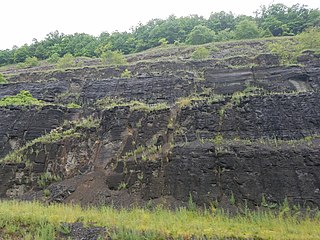Related Research Articles

Conodonts are an extinct group of agnathan (jawless) vertebrates resembling eels, classified in the class Conodonta. For many years, they were known only from their tooth-like oral elements, which are usually found in isolation and are now called conodont elements. Knowledge about soft tissues remains limited. They existed in the world's oceans for over 300 million years, from the Cambrian to the beginning of the Jurassic. Conodont elements are widely used as index fossils, fossils used to define and identify geological periods. The animals are also called Conodontophora to avoid ambiguity.
The Kasimovian is a geochronologic age or chronostratigraphic stage in the ICS geologic timescale. It is the third stage in the Pennsylvanian, lasting from 307 to 303.7 Ma. The Kasimovian Stage follows the Moscovian and is followed by the Gzhelian. The Kasimovian saw an extinction event which occurred around 305 mya, referred to as the Carboniferous Rainforest Collapse. It roughly corresponds to the Missourian in North American geochronology and the Stephanian in western European geochronology.

The Gzhelian is an age in the ICS geologic timescale or a stage in the stratigraphic column. It is the youngest stage of the Pennsylvanian, the youngest subsystem of the Carboniferous. The Gzhelian lasted from 303.7 to 298.9 Ma. It follows the Kasimovian age/stage and is followed by the Asselian age/stage, the oldest subdivision of the Permian system.
Paleontology or palaeontology is the study of prehistoric life forms on Earth through the examination of plant and animal fossils. This includes the study of body fossils, tracks (ichnites), burrows, cast-off parts, fossilised feces (coprolites), palynomorphs and chemical residues. Because humans have encountered fossils for millennia, paleontology has a long history both before and after becoming formalized as a science. This article records significant discoveries and events related to paleontology that occurred or were published in the year 1932.
The Moscovian is in the ICS geologic timescale a stage or age in the Pennsylvanian, the youngest subsystem of the Carboniferous. The Moscovian age lasted from 315.2 to 307 Ma, is preceded by the Bashkirian and is followed by the Kasimovian. The Moscovian overlaps with the European regional Westphalian stage and the North American Atokan and Desmoinesian stages.

Paleontology in Oklahoma refers to paleontological research occurring within or conducted by people from the U.S. state of Oklahoma. Oklahoma has a rich fossil record spanning all three eras of the Phanerozoic Eon. Oklahoma is the best source of Pennsylvanian fossils in the United States due to having an exceptionally complete geologic record of the epoch. From the Cambrian to the Devonian, all of Oklahoma was covered by a sea that would come to be home to creatures like brachiopods, bryozoans, graptolites and trilobites. During the Carboniferous, an expanse of coastal deltaic swamps formed in areas of the state where early tetrapods would leave behind footprints that would later fossilize. The sea withdrew altogether during the Permian period. Oklahoma was home a variety of insects as well as early amphibians and reptiles. Oklahoma stayed dry for most of the Mesozoic. During the Late Triassic, carnivorous dinosaurs left behind footprints that would later fossilize. During the Cretaceous, however, the state was mostly covered by the Western Interior Seaway, which was home to huge ammonites and other marine invertebrates. During the Cenozoic, Oklahoma became home to creatures like bison, camels, creodonts, and horses. During the Ice Age, the state was home to mammoths and mastodons. Local Native Americans are known to have used fossils for medicinal purposes. The Jurassic dinosaur Saurophaganax maximus is the Oklahoma state fossil.

The Bluestone Formation is a geologic formation in West Virginia. It is the youngest unit of the Upper Mississippian-age Mauch Chunk Group. A pronounced unconformity separates the upper boundary of the Bluestone Formation from sandstones of the overlying Pennsylvanian-age Pocahontas Formation.

Polygnathus is an extinct genus of conodonts.
Spathognathodus is an extinct conodont genus in the family Spathognathodontidae. It is a non-Platform conodont, from the Pennsylvanian (Carboniferous).
Idiognathodus is an extinct conodont genus in the family Idiognathodontidae.
Gnathodontidae is an extinct conodont family in the order Ozarkodinida. It consists of the extinct genus Icriodus.
Diplognathodus is an extinct genus of conodonts in the family Anchignathodontidae. Specimens are found in Carboniferous and Permian formations.
Clarkina is an extinct genus of conodonts. It is considered to be an offshore, outer shelf or basinal, deep-water taxon.
Streptognathodus is an extinct genus of conodonts from the Late Carboniferous to Early Permian.
Neognathodus is an extinct genus of conodonts.
Declinognathodus is an extinct genus of platform conodonts.
Idiognathoides is an extinct genus of conodonts.

Cavusgnathus is an extinct genus of conodonts.
Polygnathodella is an extinct genus of conodont.
Misikella is an extinct genus of conodonts.
References
- ↑ Texas Pennsylvanian conodonts and their stratigraphic relations. CR Stauffer, HJ Plummer - University of Texas Bulletin, 1932
- ↑ The Pennsylvanian conodont genus Gondolella Stauffer & Plummer, 1932: reinterpretation of the original type specimens and concepts. Glen K. Merrill and Peter H. Von Bitter, Journal of Micropalaeontology, volume 26, issue 1, pages 41-46, April 2007, doi : 10.1144/jm.26.1.41